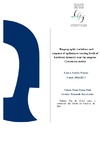Identificador persistente para citar o vincular este elemento:
https://accedacris.ulpgc.es/jspui/handle/10553/55941
| Campo DC | Valor | idioma |
|---|---|---|
| dc.contributor.advisor | Tuya Cortés, Fernando José | - |
| dc.contributor.advisor | Tomas Nash, Fiona | - |
| dc.contributor.author | Antich Homar, María Laura | - |
| dc.date.accessioned | 2019-07-04T13:12:27Z | - |
| dc.date.available | 2019-07-04T13:12:27Z | - |
| dc.date.issued | 2017 | en_US |
| dc.identifier.uri | https://accedacris.ulpgc.es/handle/10553/55941 | - |
| dc.description.abstract | Seagrasses worldwide constitute a key habitat on shallow soft bottoms, but they are experiencing a rapid decline affecting biodiversity. In order to determine how habitat structure may influence processes that shape faunal communities, we experimentally assessed the effects of different levels of herbivory intensity over the seagrass C. nodosa on the composition and abundance of associated epifauna. We tested these effects at two regions throughout the distribution range of C. nodosa: the Canary Islands (Gran Canaria) and the Balearic Islands (Mallorca). High herbivory was simulated by clipping seagrass leaves in 5 plots with respect to 5 control plots. Epifaunal abundances and taxon richness differed between regions and treatment. These effects varied amongst epifaunal taxonomic groups, as well as when considering their abundances per area or per biomass of seagrass. For several groups, epifaunal responses to seagrass clipping were the opposite at the two regions. These results highlight the importance of carrying out experimental comparisons at multiple sites to obtain a more complete understanding of ecological patterns and processes governing marine benthic communities. | en_US |
| dc.language | eng | en_US |
| dc.relation | Compresion Holistica Del Funcionamiento y Resilencia de Una Fanerogama Marina A Perturbaciones Locales: de Escalas Moleculares A Escalas | en_US |
| dc.subject | 240106 Ecología animal | en_US |
| dc.subject.other | Seagrass | en_US |
| dc.subject.other | Cymodocea nodosa | en_US |
| dc.subject.other | Herbivory | en_US |
| dc.subject.other | Epifauna | en_US |
| dc.title | Biogeographic variations and response of epifauna to varying levels of herbivory intensity over the seagrass "Cymodocea nodosa" | en_US |
| dc.type | info:eu-repo/semantics/bachelorThesis | en_US |
| dc.type | BachelorThesis | en_US |
| dc.contributor.departamento | Departamento de Biología | en_US |
| dc.contributor.facultad | Facultad de Ciencias del Mar | en_US |
| dc.investigacion | Ciencias | en_US |
| dc.type2 | Trabajo final de grado | en_US |
| dc.utils.revision | Sí | en_US |
| dc.identifier.matricula | TFT-42273 | es |
| dc.identifier.ulpgc | Sí | en_US |
| dc.contributor.buulpgc | BU-BAS | en_US |
| dc.contributor.titulacion | Grado en Ciencias del Mar | es |
| item.grantfulltext | open | - |
| item.fulltext | Con texto completo | - |
| crisitem.project.principalinvestigator | Tuya Cortés, Fernando José | - |
| crisitem.advisor.dept | GIR ECOAQUA: Biodiversidad y Conservación | - |
| crisitem.advisor.dept | IU de Investigación en Acuicultura Sostenible y Ec | - |
| crisitem.advisor.dept | Departamento de Biología | - |
| Colección: | Trabajo final de grado | |
Visitas
116
actualizado el 12-jul-2025
Descargas
49
actualizado el 12-jul-2025
Google ScholarTM
Verifica
Comparte
Exporta metadatos
Los elementos en ULPGC accedaCRIS están protegidos por derechos de autor con todos los derechos reservados, a menos que se indique lo contrario.
